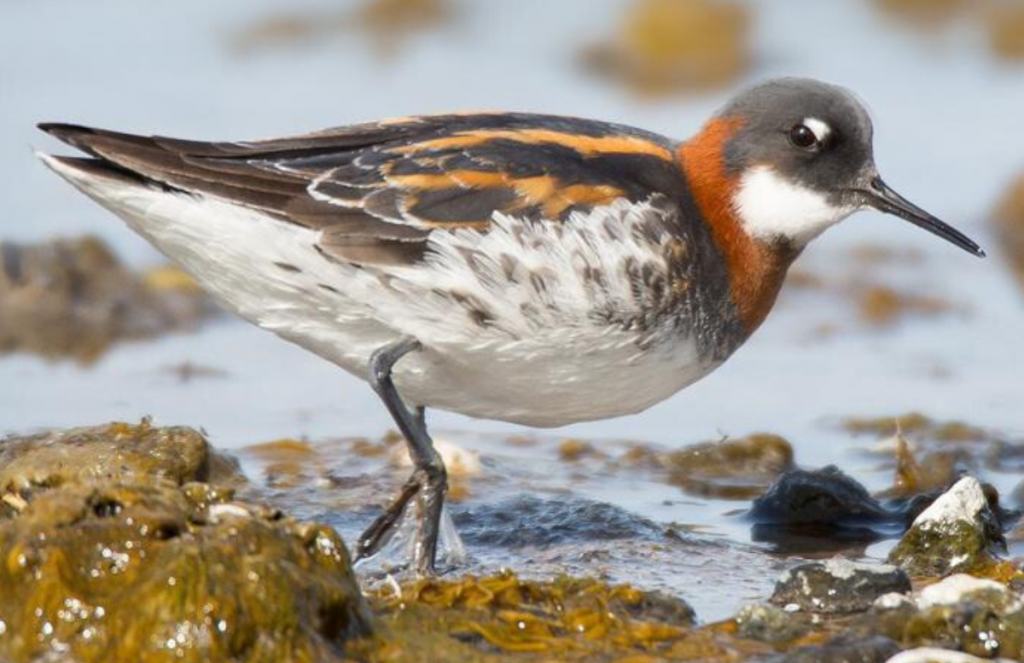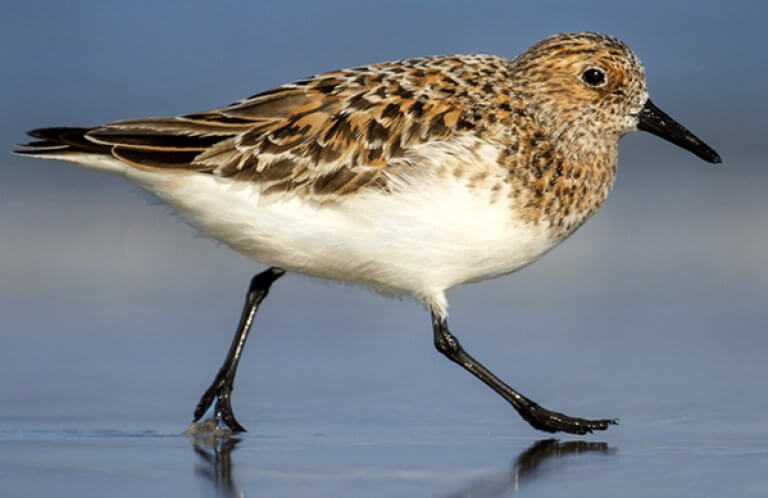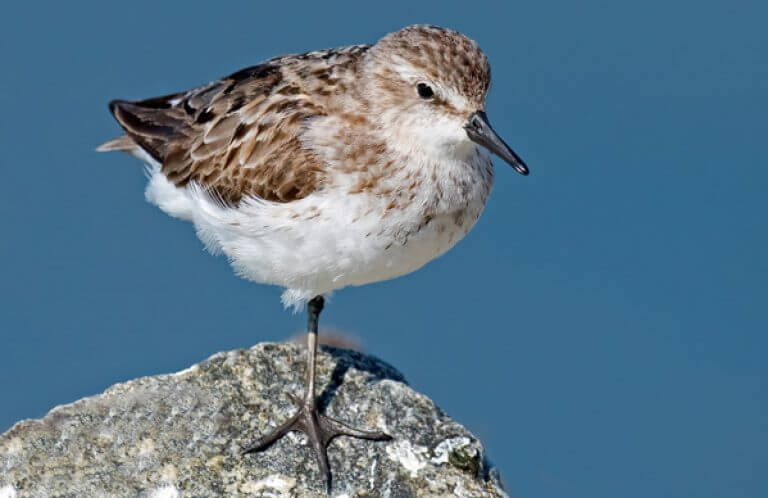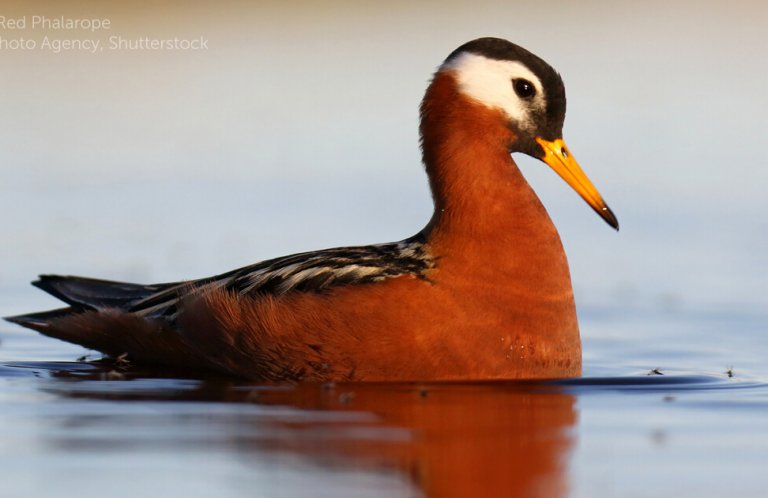About the Red-necked Phalarope
Only an inch longer than a Downy Woodpecker, the dainty-looking Red-necked Phalarope is a tough bird that opens our eyes in many ways, even if many of us rarely if ever see it. During the breeding season, this species is more colorful than many other sandpipers such as the Sanderling or Semipalmated Sandpiper. (Although at other times of year, it's feathered in gray and white, with black accents.) The Red-necked Phalarope defies our assumptions in other ways as well, and lives in some of the planet's harshest environments.
Guess Again
People often think they know how birds "tick," but curious readers of natural history know better than to assume all feathered creatures are alike. Phalaropes have certainly opened the eyes of ornithologists over the years.
During most sandpiper and plover species' breeding seasons, either the female or both sexes incubate the eggs and broods the young. Yet only male phalaropes perform these duties. In many other bird species, the males have more colorful plumage than do females during the breeding season; this too is reversed in phalaropes. Then, in winter, when most shorebirds are tiptoeing across mudflats, through short grass, or in shallow waters, Red-necked Phalaropes are found on roiling open ocean, landing on the water and foraging like some seabirds.
These differences between phalaropes and other shorebirds have some ornithologists wondering if they should be in a separate family from "typical" sandpipers, the way plovers are their own family, for example.
Songs and Sounds
While feeding, associating with others, and in flight, Red-necked Phalaropes emit an oft-repeated "kep" call.
Listen here:
Breeding and Feeding
Daddy Daycare
Female Red-necked Phalaropes often battle each other for mates, and females follow often-dismissive males until pair bonds are established and mating occurs. A pair usually locates their nest along the edges of a tundra pond or pool. The female starts looking for sites first, followed a few days later by the male. Often a few scrape sites are cleared before one is chosen. At the chosen scrape, the female lays the first of four eggs. The male then starts grabbing nearby materials — often sedges, lichens, and grasses — flinging them to the site. Over the next several days, he constructs the nest as subsequent eggs are laid, about one per day.
The male begins incubating the eggs after the third egg is laid, continuing until they all hatch, almost three weeks later. The downy, leggy young amble out of the nest less than a day after hatching, and can feed themselves, but the male attends them for about two weeks, brooding them when they are small, leading them to productive feeding spots, and sounding the alarm and trying to distract any predators that appear.
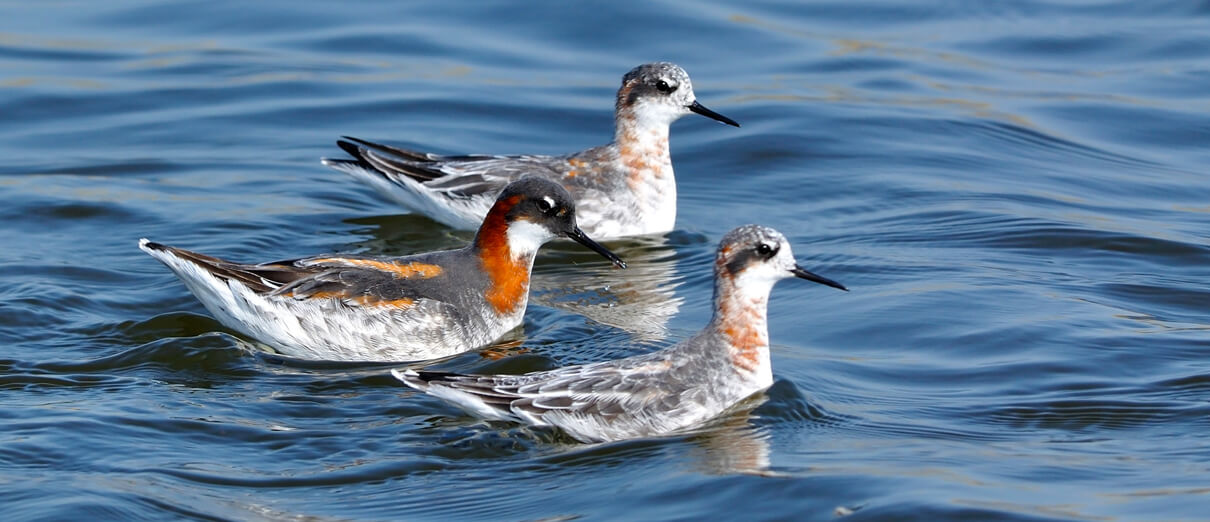
Twirling for Food
The Red-necked Phalarope usually feeds in deeper water than do other shorebirds because it swims rather than wades. Its foraging style is frenetic, as if the birds are highly caffeinated: Most often, they chug through the water in a more-or-less straight line, darting here and there to nab tiny prey with their thin, pencil-straight bills. But phalaropes are best known for their other regular feeding technique — spinning in tight, continuous circles. This behavior is believed to create upwellings that draw up prey from below the water's surface. This movement might also stimulate otherwise-still prey to stir.
These birds mostly feed on tiny invertebrates they find at or near the water's surface. On tundra nesting grounds, they focus heavily on flies and their eggs, but also take beetles, spiders, and other small invertebrates. On the open ocean, Red-necked Phalaropes eat plankton, including tiny crustaceans and mollusks and some fish eggs, often at upwellings or where waters converge. At times, they feed alongside whales, fish, and other birds. In the West, they can gather in huge numbers at saline lakes during fall migration, including at Utah's Great Salt Lake and California's Mono Lake. There, they primarily eat brine-fly adults, larvae, and pupae.
Region and Range

The Red-necked Phalarope breeds across the "top" of the world, nesting on tundra from Alaska and across northern Canada to Greenland, coastal Scandinavia, and across Russia's northern fringe to the Kamchatka Peninsula and the islands ranging east toward Alaska.
In the Americas, this bird winters well offshore in the Pacific, from off southern Mexico to the Galápagos and in waters far off the coast of Peru and Chile.
During migration, Red-necked Phalaropes turn up in a variety of watery habitats, both inland (particularly in the West), along the coasts, and offshore. Briny lakes host large concentrations during fall migration.
Conservation
Both what is known and not known about this phalarope has a bearing on the species' future. Ornithologists are puzzled and troubled by records of once-huge pre-migration assemblages of millions of Red-necked Phalaropes in Canada's Bay of Fundy and in Japan that no longer occur. In addition, much remains to be learned about this species' migration and especially its habits at sea, where these birds spend up to nine months of the year, making it hard to know how human activities in the oceans affect the species.
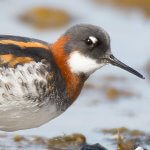
Help support ABC's conservation mission!
On nesting grounds, a warming climate is expected to have an impact on this tundra-nesting species, as permafrost thaws and the treeline creeps northward. Also, habitat loss from expanding oil development and burgeoning Snow Goose populations impact these birds' fragile breeding habitats.
In September 2023, ABC joined other conservation and community groups in a lawsuit against the state of Utah for its failure to ensure that enough water reaches the Great Salt Lake to prevent its ecological collapse. The lake is of critical importance to thousands of migrating birds including the Red-necked Phalarope, Wilson's Phalarope, Eared Grebe, and Marbled Godwit.
Get Involved
Policies enacted by the U.S. Congress and federal agencies, such as the U.S. Fish and Wildlife Service, have a huge impact on migratory birds. You can help shape these rules for the better by telling lawmakers to prioritize birds, bird habitat, and bird-friendly measures. To get started, visit ABC's Action Center.
Living a bird-friendly life can have an immediate impact on migratory birds in the United States. Doing so can be as easy as adding native plants to your garden, avoiding pesticides, and keeping cats indoors. To learn more, visit our Bird-Friendly Life page.
American Bird Conservancy and our Migratory Bird Joint Venture partners have improved conservation management on more than 8.5 million acres of U.S. bird habitat — an area larger than the state of Maryland — over the last ten years. That's not all: With the help of international partners, we've established a network of more than 100 areas of priority bird habitat across the Americas, helping to ensure that birds' needs are met during all stages of their lifecycles. These are monumental undertakings, requiring the support of many, and you can help by making a gift today.





































